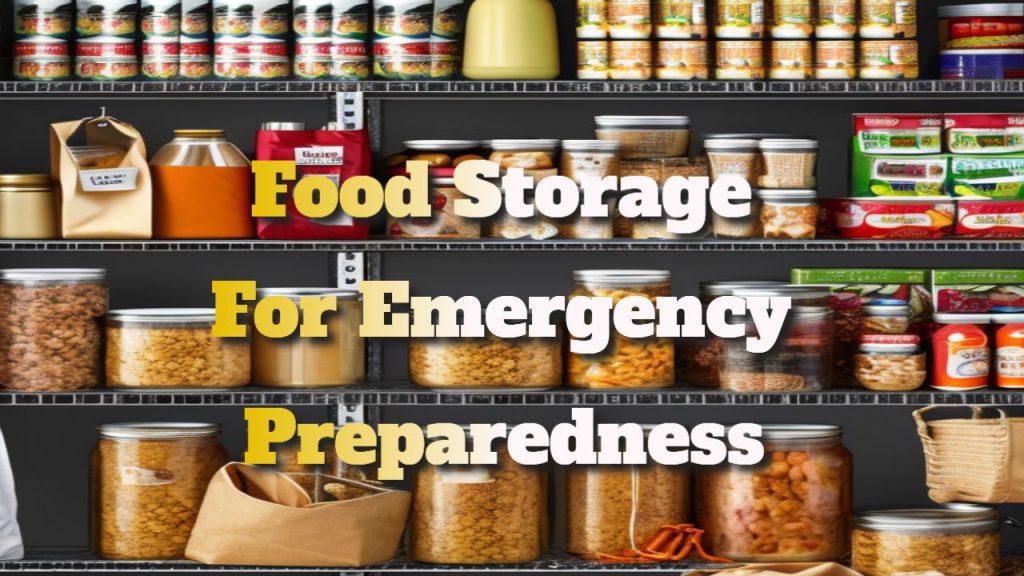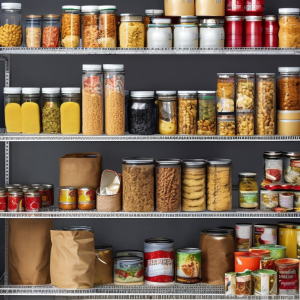Guide to Food Storage for Emergency Preparedness
Did you know 60% of Americans must be appropriately prepared in an emergency? A well-stocked pantry can be a saviour when calamity strikes. But where do you begin? How can you ensure that your food supply is enough and well-maintained?
In this article, we’ll cover all you need to know about emergency food storage, from the food you should keep on hand to the best methods for storing and rotating your supply.
Read on to learn how to defend yourself and your loved ones in times of catastrophe, whether you’re a seasoned prepper or just getting started with emergency preparedness.
The significance of food storage
It is critical to store food properly to keep it fresh and reduce wastage. Food that is properly stored will stay longer and be safe to eat.
You can slow bacterial development and maintain food quality by storing perishable food at the proper temperature and conditions.
Consequently, fewer trips to the grocery store and less food wasted are the results.
Furthermore, correctly storing food helps you save money by limiting the amount of food you toss. You can readily see what you have on hand and avoid buying more unnecessary things if you organise your pantry and fridge effectively.
You can have delicious and healthful meals while minimising wastage if you keep your food properly.
Food that is essential for emergency preparedness
It is critical to maintain a stock of basic food supplies on hand in case of an emergency. These meals should be non-perishable, simple to prepare, and have enough nutrients to keep you going in an emergency.
Begin by storing canned items like veggies, fruit, and protein like tuna or chicken. They are versatile and can be eaten directly from the can or added to many other meals.
Remember grains like rice and pasta, which are versatile and may be stored for an extended period. Dried beans and lentils, which are vital in protein and have a long shelf life, are other ideal options.
Finally, consider the power of comfort foods like chocolate or snacks to lift your spirits during stressful situations.
Storage strategies that work
First, keep your food in a cold, dry place with a consistent temperature. Keep away from extremely hot or humid conditions to prevent spoilage and damage.
Second, avoid contact with air and moisture by using airtight containers or vacuum-sealed bags. This will keep your food’s flavour, texture, and nutritional value.
Shelf life and rotation suggestions
Knowing the shelf life will assist you in determining when to use up or replace specific goods.
The shelf life of most emergency foods ranges from 1 to 25 years, depending on the type of food and its container. Regularly checking the expiration date and refilling your supplies accordingly is critical.
This entails consuming the oldest food first and restocking your resources with new food.
Additional considerations for emergency food storage
Ensure your emergency provisions are stored properly to maintain their durability and nutritional content. Other considerations to consider while storing food for emergencies include shelf life and rotation.
First, ensure your storage place is cool, dry, and out of direct sunlight. High heat and humidity can hasten deterioration and impair food’s nutritional value.
Store food in an airtight container to keep it fresh for longer and protect it from spoilage, insects, and oxygen. This contributes to the food’s quality and safety.
Remember to name and date your food containers to keep track of the expiration date and rotate your supplies as needed.
Lastly, make sure to regularly inspect your emergency supplies for any indications of damage or degradation. If necessary, replace them.
By taking these extra precautions, you can ensure that your emergency food supplies are safe, healthy, and ready to use when needed.
Commonly Asked Questions
What are the most common blunders to avoid when stockpiling food for an emergency?
There are some typical mistakes to avoid when stockpiling food for emergency preparedness. One of these blunders is failing to rotate your supplies regularly. To guarantee that nothing goes to waste, check food stockpiles regularly and use up the oldest stuff first.
Another blunder to avoid is failing to close containers properly. To minimise deterioration and contamination, using airtight containers when storing food for emergencies is critical. This will aid in preserving the quality and safety of your food sources.
Furthermore, when arranging emergency food supplies, it is critical to consider dietary limitations or allergies—plan for options that address the individual needs of all members of your home. In an emergency, this will ensure that everyone is well-fed.
Can I store food in standard household containers, or do I need to invest in specific storage containers?
You should purchase proper food storage containers. Standard household containers may not be airtight or long-lasting enough to hold emergency food.
It is critical to maintain the safety and longevity of your stored food.
How can I keep my emergency supplies safe and secure during a power outage?
Follow the advice below to keep your food safe during a power outage:
1) Keep food in a cold, dry location.
2) Use tightly sealed containers.
3) Change the food regularly and check the expiry date.
When stockpiling food for emergencies, are there any additional considerations for those with dietary restrictions or food allergies?
It is critical to consider any dietary restrictions or allergies while stocking food for emergencies.
Make sure you stock up on meals that will fulfil your demands without causing health issues.
What are some inventive ways to incorporate emergency supplies into daily meals to reduce waste and promote rotation?
Get creative with incorporating emergency rations into daily meals to reduce waste! Smoothies can benefit from canned fruit. Soups can benefit from the addition of dehydrated veggies. Prepare canned meat pasta meals. To spice up your meals, try combining different ingredients!
Any preparedness plan must include a well-stocked and carefully stored emergency food supply.
Understanding the importance of food storage, as well as identifying the essential foods and storing them properly, will help maintain the longevity and quality of your emergency supplies.
Remember to check the shelf life of stored items regularly and rotate them as needed.
You will be prepared for any unanticipated circumstances if you consider these factors.
Stay safe and prepared.
The post Guide to Food Storage for Emergency Preparedness appeared first on Survival Avenue.
The Article Guide to Food Storage for Emergency Preparedness was found on https://limitsofstrategy.com



